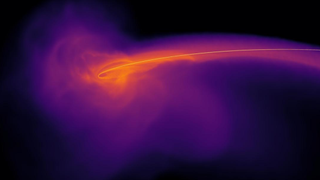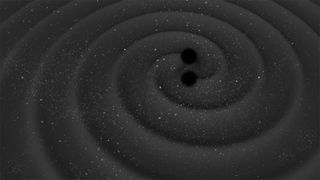“What happens when you throw a star at a black hole?” It’s not a question we can physically answer here on Earth. Thankfully, actual black holes and stars can’t be smashed together in the lab! However, scientists can use advanced supercomputer modeling to simulate a black hole ripping apart and devouring a star in a so-called “tidal disruption event” or “TDE.” Doing just that, a team of researchers led by Danel Price from Monash University has discovered that the answer to our opening question is “things get messy.” “Black holes…
Read MoreTag: Black Holes
Small black holes could play ‘hide-and-seek’ with elusive supermassive black hole pairs
Binary pairings of small black holes could be used by astronomers in a cosmic game of “hide-and-seek” to hunt much larger, yet more elusive, supermassive black hole binaries. The technique could, therefore, help solve the mystery of how supermassive black holes grew so fast in the early universe. Detecting black holes is no easy task despite their reputation as fearsome cosmic titans. All black holes are surrounded by a one-way light-trapping boundary called an “event horizon” that ensures they emit no light. Even the supermassive black holes at the hearts…
Read MoreNASA’s Fermi Finds New Feature in Brightest Gamma-Ray Burst Yet Seen
4 min read NASA’s Fermi Finds New Feature in Brightest Gamma-Ray Burst Yet Seen In October 2022, astronomers were stunned by what was quickly dubbed the BOAT — the brightest-of-all-time gamma-ray burst (GRB). Now an international science team reports that data from NASA’s Fermi Gamma-ray Space Telescope reveals a feature never seen before. The brightest gamma-ray burst yet recorded gave scientists a new high-energy feature to study. Learn what NASA’s Fermi mission saw, and what this feature may be telling us about the burst’s light-speed jets. Credit: NASA’s Goddard Space…
Read MoreA massive black hole may be ‘waking up’ in a nearby galaxy
In December of 2019, the sky-scanning Zwicky Transient Facility — a telescope perched on California’s Palomar Mountain — alerted astronomers to a sudden flare coming from an otherwise unremarkable galaxy some 300 million light-years from Earth in the constellation Virgo. The flare’s intensity dipped and peaked dramatically over four years, but it continues to persist even today. That’s unusually long for such a flare — so long, in fact, that it can’t be explained by any typical cosmic phenomena. “This behavior is unprecedented,” Paula Sánchez-Sáez, an astronomer at the European…
Read MoreHow 2 quasars at the dawn of time could be a Rosetta stone for the early universe
A double quasar spiraling toward a great merger has been discovered lighting up the “cosmic dawn,” just 900 million years after the Big Bang. They are the first quasar pair spotted that far back in cosmic time. Quasars are rapidly growing supermassive black holes in the cores of hyperactive galaxies. Torrents of gas are thrust down the black holes’ throats and get hung up in the bottleneck of an accretion disk, which is a dense ring of ultrahot gas that is queuing up to fall into the black hole. Not…
Read MoreHubble Telescope maps high-speed ‘burps’ from nearby feeding supermassive black hole for 1st time
Using the Hubble Space Telescope, astronomers have, for the first time ever, mapped the plasma “burps” of a feeding supermassive black hole-powered quasar that dwells relatively close to Earth. While supermassive black holes with masses millions or billions of times that of the sun are thought to dwell at the heart of all galaxies, not all of these cosmic titans power quasars. Some, like the supermassive black hole at the heart of the Milky Way, called Sagittarius A*, are relatively quiet because they are not greedily feeding on matter around…
Read MoreBlack hole singularities defy physics. New research could finally do away with them.
Black holes are some of the most enigmatic objects in the universe, capable of deforming the fabric of space around them so violently that not even light can escape their gravitational grip. But it turns out, much of what scientists know about these mysterious objects could be wrong. According to new research, published in April in the journal Physical Review D, black holes could actually be entirely different celestial entities known as gravastars. “Gravastars are hypothetical astronomical objects that were introduced [in 2001] as alternatives to black holes,” study co-author…
Read MoreRight again, Einstein! Scientists find where matter ‘waterfalls’ into black holes
Scientists have confirmed, for the first time, that the very fabric of spacetime takes a “final plunge” at the edge of a black hole. The observation of this plunging region around black holes was made by astrophysicists at Oxford University Physics, and helps validate a key prediction of Albert Einstein’s 1915 theory of gravity: general relativity. The Oxford team made the discovery while focusing on regions surrounding stellar-mass black holes in binaries with companion stars located relatively close to Earth. The researchers utilized X-ray data collected from a range of…
Read MoreCracking! Some binary black holes may roll around each other in egg-shaped orbits
Black hole week reaches its conclusion today (May 10), and there’s no better way to mark the occasion than with some “eggs-traordinary” black hole science. Using gravitational wave measurements by the Laser Interferometer Gravitational-Wave Observatory (LIGO), based in the U.S., and the Virgo and KAGRA detectors, located in Italy and Japan, respectively, scientists have found that the orbits of some binary black holes could be egg-shaped and exhibit a curious wobble. This research is more than a mere curiosity (and an “eggs-cuse” to crack some bad egg-related puns). The discovery…
Read MoreNASA’s Roman Space Telescope will hunt for the universe’s 1st stars — or their shredded corpses, anyway
NASA’s forthcoming Nancy Grace Roman Telescope could use the grisly death of stars ripped apart by black holes to hunt the universe’s first population of stellar bodies. These early stars, referred to (somewhat confusingly) as Population III (Pop III) stars, were very different from the sun and other stars seen in the cosmos today. That’s because the universe wasn’t yet filled with “metals,” the term astronomers use to describe elements heavier than hydrogen and helium. Pop III stars arose just a few hundred million years after the Big Bang and…
Read More








